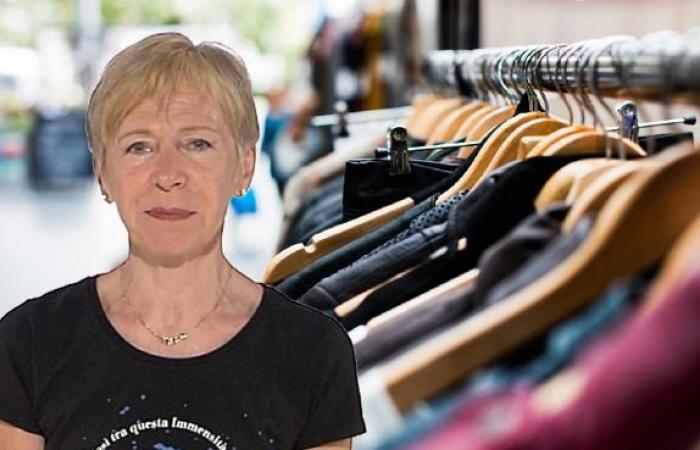In the contemporary world of fashion, two diametrically opposed phenomena coexist. The first is the one already mentioned fast fashionthe disposable fashion of Shein, Zara, H&M, Primark. The second is second-hand clothing. Generation Z finds itself at the center of these two trends. On the one hand, it continues to lead the fast fashion sector (as highlighted by the Shein investigation) due to its accessibility at very low cost, but with a very high environmental impact; on the other hand it is a leader in the world of fashion second handfor more sustainable consumption practices, in favor of a market which, according to thredUP’s 2024 annual report, will reach the dizzying figure of 350 billion dollars by 2028. In the USA has already far outpaced the broader apparel retail sector, reaching the figure of 43 billion dollars in 2023. Forecasts say it will rise to 73 billion by 2028.
Where it is bought and where it is sold
It is bought and sold online: according to e-commerce traffic data provided by Similarweb, in the second-hand sector Poshmark leads the United States with an average of 51 million visits per month, followed by ThredUp with 14 million and TheRealReal with 13 million. As regards the European panorama Vinted establishes itself as a leader in Italy with 5.8 million visits per month and 25.8 million in France. Wallapop emerges in the Spanish market with almost 22 million monthly visits. According to theBVA Doxa Second Hand Economy Observatory 2023 For Right awayin Italy second-hand clothes had a turnover of 7.1 billion euros in 2023.
Buying second-hand clothing, rather than new, can reduce carbon emissions by 25%.
Two sides of the same coin
At the same time, on a global level, a new ultra-fast fashion online platform is rapidly gaining ground: the Chinese one Temutwin of Sheinlaunched in Europe in 2023. Data from Similarweb indicate that the platform averages 104 million monthly visits in the United States, surpassing even established platforms such as Zalando, despite the latter’s commitment to implementing corporate sustainability programs. Two trends that reflect the contradictions and potential of generation Z in shaping the future of fashion and the environment. With over 100 billion items of clothing produced globally every year, fashion has a serious overproduction problem. Buying second-hand clothing, rather than new, can reduce carbon emissions by 25%.
How to clear out your closet
In practice those who want to free up the closet in a responsible and sustainable way has several options: you can go to second-hand markets managed by franchises such as Franchising Market, Mercatopoli or Kece. Alternatively, you can choose independent shops or use apps and shopping sites online as Vinted, Vestiaire Collective, Subito, Depop, eBay, Zalando And Wallapop. The process is simple. First of all the clothes must be in good condition, washed and ironed. They must then be taken to the chosen point of sale, where they are evaluated to determine the price. In some cases it may be necessary to register at the market with a personal card. Once accepted, the clothes are displayed on consignment. When an item is sold the owner receives 50% of the proceeds which can be collected at the cash register on the first day of the following month. Clothes not sold within 30 or 60 days may be discounted. After this period, the owner can collect the unsold clothes or let the shop put them to charity, or donate them personally to charities. If they are too damaged they are not considered rubbish, but it is advisable to take them to the fabric section of your city’s eco-centre or to the municipal collection centres. For those who prefer to manage the sales process themselves, apps and online buying and selling sites offer a convenient alternative. Here you need to upload the photos online, indicate the price and send the item to the interested buyer.
The pillar of the modern economy
Behind the concept of used, however, there is the cornerstone of the modern economy, the circular one, ranging from clothing to furniture to electronics: purchasing refurbished smartphones, laptops and other devices reduces electronic waste and the demand for new resources. For example, buying second-hand furniture (such as sofas, tables and chairs) avoids the use of new raw materials. According to theBVA Doxa Second Hand Economy Observatory 2023 For Right away60% of Italians joined the second hand market during 2023, reaching 1.3% of GDP. In parallel with this increase in revenues, the number of Italians who dedicated themselves to purchasing used products also grew significantly in the period considered, going from 19 million in 2014 to 26 million in 2023. Lombardy, Campania, Lazio and Veneto are the lead regions.
The consequences of the circular economy
Circular economy means transforming the linear “take-produce-use-disposal” model into a continuous cycle of reuse of resources. We start from reducing the quantity of resources extracted and waste production, leading to the design of more durable, repairable and reusable products. The aim is to keep a product in circulation for as long as possible, thus reducing the need to produce new materials. Finally, there is recycling or the recovery of materials and products at the end of their life cycle, transforming them into new useful resources for the production of other goods rather than a problem to be disposed of. It is the extreme concept of “zero waste”. A model that offers an effective solution to global challenges such as climate change, resource scarcity and environmental pollution. And at the same time it promotes innovation, paving the way for a more prosperous and sustainable future. The road that leads to a world driven by the circular economy (if there ever will be one) is very long. Today only 7.2% of the global economy adheres to this modelbut the awareness of each individual can move mountains.
The positive effects of second hand on the environment
According to The Second Hand Effect 2022 Report by Adevinta in collaboration with the consultancy company Ethos and theIVL Swedish Environmental Research Institute, the actions of users of the digital platforms examinedas Leboncoin, mobile.de, Kleinanzeigen, Marktplaat, Fotocasa, Habitaclia and InfoJobs, Subito.it, OLX Brasilthey allowed us to potentially save 25.3 million tons of CO2 emissions in 2022. The equivalent of the emissions produced by 4 million petrol cars circumnavigating the globe. Furthermore, the second-hand effect made it possible to save 1.5 million tons of plastic; 9.1 million tonnes of steel and 0.9 million tonnes of aluminium. Translated into everyday objects, this corresponds to 28 billion 2-litre PET bottles, 91 million plastic rubbish bins, 62 million cans, 358 million bicycles and 30 billion mobile phones.





